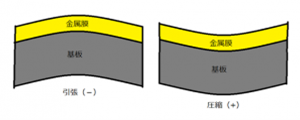In Tecdia's products, a pivotal part of the proper functioning of a capacitor is the adhesion of the metallization to its substrate. Without good adhesion, the metallization on chips will easily peel off the substrate.
テクダイヤのコンデンサ(SLC)製品では、製品の性能や信頼性を担保するために、金属膜の基板への密着性が重要です。十分な密着性がなければ、金属膜は基板から簡単に剥がれてしまいます。
Summary of Factors Affecting Metallization/Substrate Adhesion (金属膜と基板の接着に影響を与える要因のまとめ)

As a result, many of Tecdia have Ti or TiW used as the bottom layer, known as the adhesion layer. Shown below is an example of a Ti/TiW-Pt-Au layer on a substrate.
そのためテクダイヤの多くの製品では、TiまたはTiW膜は追加されています。その結果、膜構成は以下のようになります:

How can adhesion be improved? Below are the main factors that affect the adhesion between a metallization and its substrate.
どのように金属膜は改善されるでしょうか?金属膜と基板の密着性に影響を与える主な要因は以下の通りです。
Metal to substrate bond (金属膜と基板の結合)
Each metal has their own characteristic ability to bond with the substrate. Metals can form bonds with the oxygen atoms found in the ceramic of the substrate. For example, Ti can form bonds with the oxygen contained in the AlO2, forming either Ti2O3 or TiO2. How favorable it is to form a bond depends on the free energy of bonding, ΔG . A negative free energy of bonding implies that the bonding is favorable, while a positive free energy implies that the bonding is unfavorable.
それぞれの金属には基板との結合性があります。金属は基板のセラミックにみられる酸素原子との結合を形成することができます。例えば、Tiは、AlO2に含まれる酸素と結合を形成し、Ti2O3またはTiO2のいずれかを形成することができます。結合を形成することがどれほど好ましいかは、結合自由エネルギーである、ΔGによって決まります。ボンディングの負の自由エネルギーはボンディングが有利であることを意味し、正の自由エネルギーはボンディングが不利であることを意味します。
Free energy of bonding numbers of Ti and Au can be compared below. (T=298K)
TiとAuの結合数の自由エネルギーは以下で比較できます。(T=298K)
Ti2O3: -1434 kJ/mol
TiO2: -883 kJ/mol
Au2O3: 75.5 kJ/mol
From these numbers, we can see that the bonding reaction for Ti is extremely favorable, while the Au-O bonding is an extremely unfavorable reaction. This is expected, as Au is known to be very difficult to oxidize.
これらの数字から、Tiのボンディング反応が極めて良好であるのに対し、Au‐Oボンディングは極めて不利な反応であることが分かります。Auは非常に無害化が困難であることが知られているため、これが予想されます。
それぞれの金属には基板との結合性があります。金属は基板のセラミックにみられる酸素原子との結合を形成することができます。例えば、Tiは、AlO2に含まれる酸素と結合を形成し、Ti2O3またはTiO2のいずれかを形成することができます。結合を形成することがどれほど好ましいかは、結合自由エネルギーである、ΔGによって決まります。ボンディングの負の自由エネルギーはボンディングが有利であることを意味し、正の自由エネルギーはボンディングが不利であることを意味します。
Free energy of bonding numbers of Ti and Au can be compared below. (T=298K)
TiとAuの結合数の自由エネルギーは以下で比較できます。(T=298K)
Ti2O3: -1434 kJ/mol
TiO2: -883 kJ/mol
Au2O3: 75.5 kJ/mol
From these numbers, we can see that the bonding reaction for Ti is extremely favorable, while the Au-O bonding is an extremely unfavorable reaction. This is expected, as Au is known to be very difficult to oxidize.
これらの数字から、Tiのボンディング反応が極めて良好であるのに対し、Au‐Oボンディングは極めて不利な反応であることが分かります。Auは非常に無害化が困難であることが知られているため、これが予想されます。
Film stress(膜応力)
A lot of Tecdia's metallizations are formed through the physical vapor deposition process (PVD), also known as sputtering. Sputtering metals on a substrate results in stress being generated, causing the entire substrate to curve. Depending on the curvature direction, stress can be compressive(-) or tension(+). Below is an image of both phenomenon:
テクダイヤのメタライズの多くは、スパッタとも呼ばれる物理蒸着法(PVD)によって形成されます。基板上に金属をスパッタすると、応力が発生し、基板全体が曲がります。曲率の方向に応じて、ストレスは引張(-)または圧縮(+)になります。以下、両現象のイメージ。

Having large stress causes the metallization to easily peel off from the substrate. Stress is composed of the following two components:
応力が大きいと、金属膜が基板から剥がれやすくなります。ストレスは次の2つの要素から構成されています。
1.Thermal stress(熱応力)
This is caused by the difference in thermal expansion coefficients between the metallization and the substrate.
これは蒸着と基板との熱膨張係数(熱膨張率)の違いによるものです。
2.Intrinsic stress(固有ストレス)
This is caused by the structure of metallization when it is sputtered. This is a function of the sputter conditions. For example, low sputter pressure results in compression, while high pressure will result in tension.
これはスパッタしたときのメタライズの構造に起因します。これはスパッタ条件の関数で、例えば低いスパッタ圧力は圧縮をもたらしますが、高い圧力は張力をもたらします。
テクダイヤのメタライズの多くは、スパッタとも呼ばれる物理蒸着法(PVD)によって形成されます。基板上に金属をスパッタすると、応力が発生し、基板全体が曲がります。曲率の方向に応じて、ストレスは引張(-)または圧縮(+)になります。以下、両現象のイメージ。

Having large stress causes the metallization to easily peel off from the substrate. Stress is composed of the following two components:
応力が大きいと、金属膜が基板から剥がれやすくなります。ストレスは次の2つの要素から構成されています。
1.Thermal stress(熱応力)
This is caused by the difference in thermal expansion coefficients between the metallization and the substrate.
これは蒸着と基板との熱膨張係数(熱膨張率)の違いによるものです。
2.Intrinsic stress(固有ストレス)
This is caused by the structure of metallization when it is sputtered. This is a function of the sputter conditions. For example, low sputter pressure results in compression, while high pressure will result in tension.
これはスパッタしたときのメタライズの構造に起因します。これはスパッタ条件の関数で、例えば低いスパッタ圧力は圧縮をもたらしますが、高い圧力は張力をもたらします。
Conclusion(結論)
To improve the adhesion between the metallization and the substrate, care must be taken in not only choosing the correct adhesion layer for the metal, but also in selecting the proper sputtering conditions to minimize the overall film stress. We work tirelessly to find the optimal metallization conditions to ensure that our products have strong metal/substrate adhesion, as well as attaining other physical and electrical properties can satisfy the demands of our customers.
金属膜と基板との密着性を改善するためには、金属に対する正しい接着層を選択するだけでなく、全体的な膜応力を最小にするための適切なスパッタ条件を選択する際にも注意が必要です。テクダイヤは、金属と基板の密着性が強く、他の物理的および電気的特性が顧客の要求を満たすことができるよう、また最適な金属膜条件を見つけらるよう最善を尽くしています。
金属膜と基板との密着性を改善するためには、金属に対する正しい接着層を選択するだけでなく、全体的な膜応力を最小にするための適切なスパッタ条件を選択する際にも注意が必要です。テクダイヤは、金属と基板の密着性が強く、他の物理的および電気的特性が顧客の要求を満たすことができるよう、また最適な金属膜条件を見つけらるよう最善を尽くしています。

